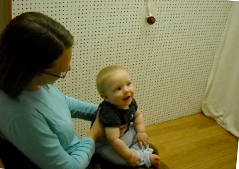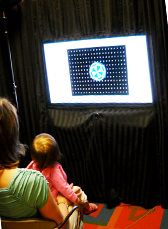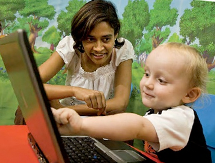Head-turn Preference Procedure

Children sit on their parent’s lap in a booth that has three lights; one in front, and two on either side. We use the flashing lights to attract the child’s attention. Once they are looking to one side, we play a sound sample. The sound sample plays as long as the child is looking at the flashing light. When they turn away, we attract their attention to the other side of the booth and play another sound file. A video camera records the child’s face to determine how much time her gaze is fixated on the flashing light. These looking time measures provide information about children’s sensitivity to speech stimuli. This listening task takes about 5 minutes to complete.
Visual Fixation Procedure

Children sit on their parent’s lap or in a highchair in front of a TV monitor on which various images are presented. First, the child’s attention is drawn to the screen with a visual display (e.g. with a flashing red light). Once the child is looking at the TV monitor, another image (e.g. a picture of a boy with five balloons) is presented on the TV monitor accompanied by audio speech stimuli (e.g. Look, he has balloons!). The audio speech stimuli plays as long as the child is looking at the screen. A video camera records the child’s face to determine how much time her gaze is fixated on combinations of video and audio displays. These looking time measures provide information about how children perceive and comprehend speech. This task usually takes between 5-10 minutes.
Comprehension / Production Task

Some research that investigates children’s perception and production abilities is conducted in our castle sound booth. In the castle, children are recorded in spontaneous play sessions, play games with an experimenter, watch a short video on a computer. At all times, parents are with their children. These studies take between 15 minutes to complete.
Preferential Looking

Children sit on their parent’s lap or in a highchair in front of a TV monitor. On the screen, we display two images or videos side-by-side. For instance, one video might show a girl opening a box, while another video might show a girl lifting a box. The videos are accompanied by audio speech stimuli (e.g., “Look, the girl is opening the box!”) A video camera records the child’s eye gaze while the speech stimuli play, and we measure which video the child prefers to look at. This provides information about how children understand sentences they hear. This task usually takes between 5-10 minutes.
